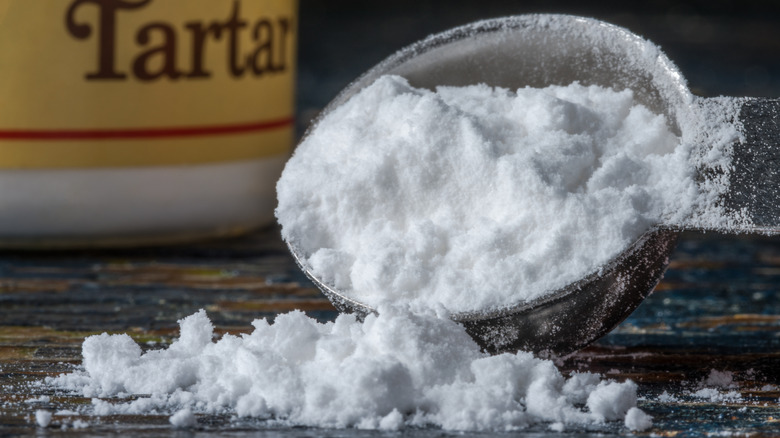You'll Probably Never Guess What Cream Of Tartar Actually Is
You may have wondered what it was in the seasoning section of some grocery store aisle or found some in someone else's pantry next to the flour while looking for a snack. But unless you're a baker, the fine white powder that is named cream of tartar is probably quite a mysterious ingredient.
According to Epicurious, the scientific designation of cream of tartar is potassium bitartrate. The foundation of cream of tartar is tartaric acid, which can be found naturally produced in grapes and can be further developed when made into wine. It is the tartaric acid that gives wine its tangy body. As wine ages, the tartaric acid mixes with other chemicals in the wine and can eventually crystalize into tartrate. If you've ever looked into an emptied wine barrel, you may have seen a layer of purple-colored crystals along the bottom and walls of the barrel. According to HowStuffWorks, these tartrates are also known as wine diamonds and ever so often they may slip into a bottle or develop on the bottom of corks.
Where does it come from where does it go (tartar-eyed Joe)
This crystalline byproduct of winemaking is what we know as cream of tartar, and it's actually quite useful in a lot of different situations. Its primary use is in cooking, primarily baking. According to Healthline, baking powder contains potassium acid tartrate which acts in bread dough by releasing carbon dioxide, making the dough rise. Cream of tartar can also be used as an anticaking agent to help prevent lumpy textures in granulated ingredients. Bakers will often also substitute cream of tartar for lemon juice, baking powder, and buttermilk.
Aside from baking, cream of tartar can also be used as a cleaning agent. Mixing potassium acid tartrate with substances like white vinegar or hydrogen peroxide can help remove rust and polish steel. You can even put it on damp clothing to potentially remove stains. From humble beginnings at the bottom of wine barrels to food additives in your cake to helping you polish your silverware, cream of tartar really does get it done.

